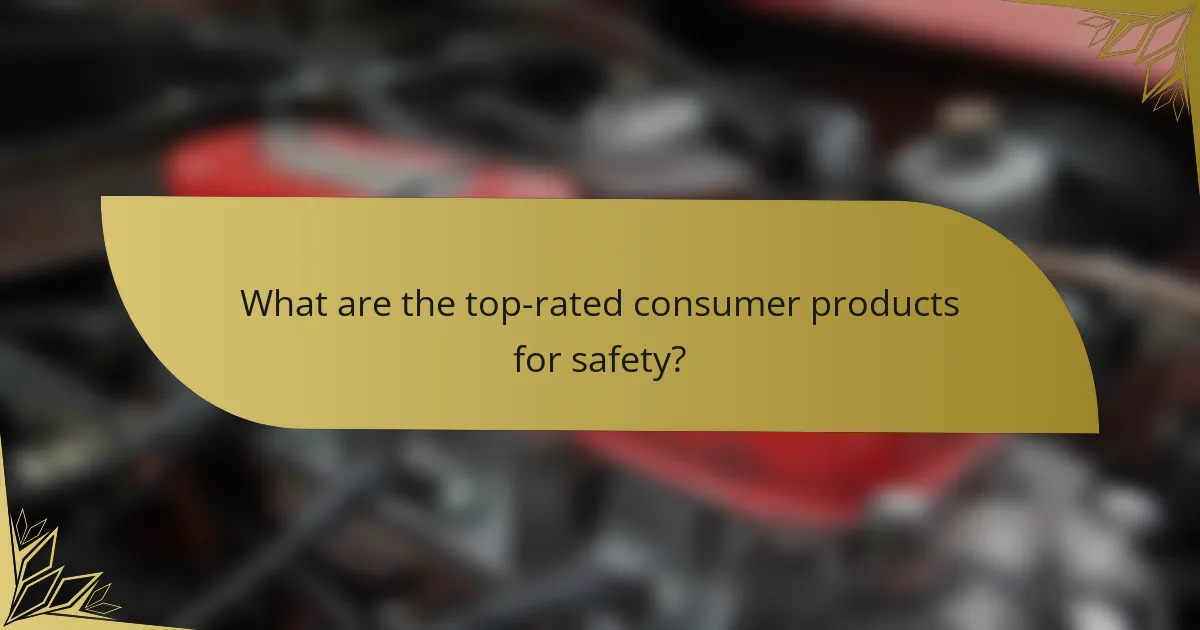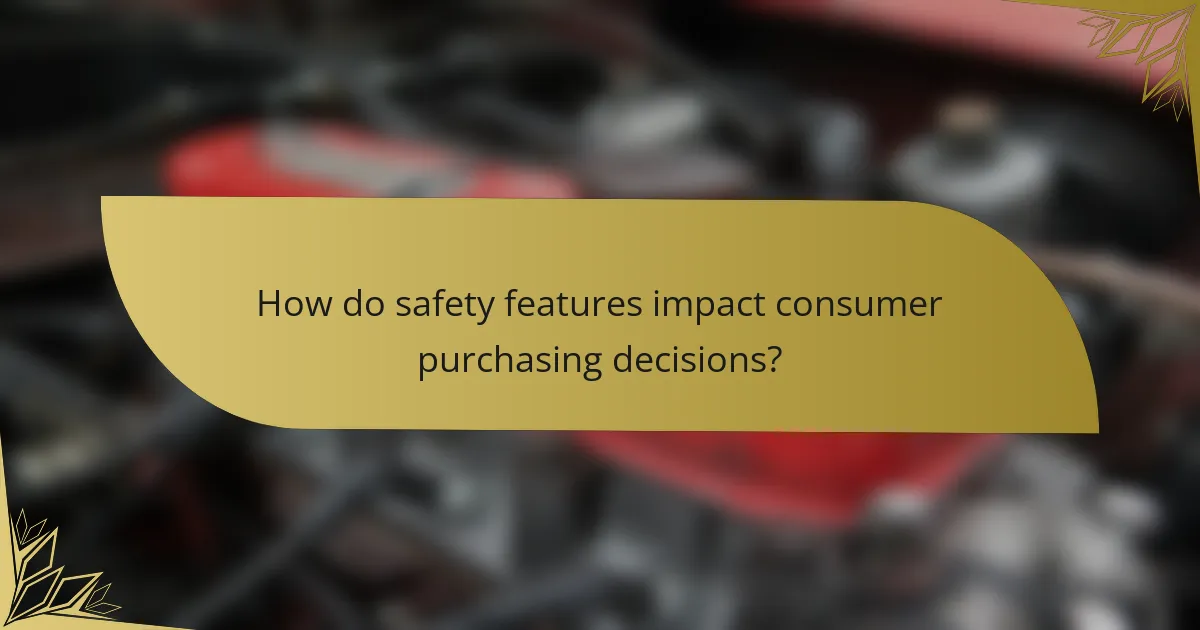In today’s market, safety features in consumer products are paramount for enhancing user protection and reducing risks. With advancements such as active safety systems and emergency braking, the effectiveness of these features is often reflected in user feedback, which varies across brands and models. Understanding the relationship between safety technology and consumer experiences is essential for making informed choices that prioritize safety and reliability.

What are the best safety features in consumer products?
The best safety features in consumer products enhance user protection and minimize risks during use. Key features include active and passive safety systems, advanced driver-assistance systems (ADAS), child safety locks, and emergency braking systems, all designed to improve overall safety and user confidence.
Active safety systems
Active safety systems are technologies that help prevent accidents before they occur. These systems often include features like anti-lock braking systems (ABS), electronic stability control (ESC), and traction control, which work together to maintain vehicle stability and control during challenging conditions.
When considering active safety systems, look for products that offer advanced features such as lane departure warnings and adaptive cruise control. These can significantly reduce the likelihood of collisions by alerting drivers to potential hazards and adjusting speed accordingly.
Passive safety features
Passive safety features are designed to protect users in the event of an accident. Common examples include airbags, seat belts, and crumple zones, which absorb impact energy and reduce injury severity. The effectiveness of these features can vary based on design and materials used.
When evaluating passive safety features, check for compliance with safety standards such as those set by the National Highway Traffic Safety Administration (NHTSA) or the European New Car Assessment Programme (Euro NCAP). Products with higher safety ratings typically offer better protection.
Advanced driver-assistance systems (ADAS)
ADAS encompasses a range of technologies that assist drivers in navigating safely. Features like blind-spot monitoring, parking assistance, and automatic emergency braking fall under this category. These systems use sensors and cameras to detect obstacles and provide real-time feedback to the driver.
For effective use of ADAS, familiarize yourself with the specific functions of the system in your vehicle. Understanding how these features operate can enhance safety and reduce the risk of accidents, especially in urban environments where traffic is dense.
Child safety locks
Child safety locks are essential for preventing accidental door openings by children while a vehicle is in motion. These locks can be engaged manually or automatically, depending on the vehicle model. They ensure that rear doors remain securely closed, providing peace of mind for parents.
When selecting a vehicle or product with child safety locks, ensure they are easy to activate and deactivate. Additionally, consider models that offer visual indicators to confirm that the locks are engaged, enhancing safety and usability.
Emergency braking systems
Emergency braking systems are designed to automatically apply the brakes when a potential collision is detected. This feature can significantly reduce the severity of an accident or prevent it altogether. Many modern vehicles incorporate this technology as part of their standard safety package.
When assessing emergency braking systems, look for features such as pedestrian detection and adaptive braking capabilities. These enhancements can improve responsiveness and effectiveness, especially in urban settings where sudden stops may be necessary.

How do user experiences vary across different brands?
User experiences with vehicle safety features can differ significantly among brands, influenced by design, technology, and consumer expectations. Factors such as reliability, ease of use, and effectiveness play a crucial role in shaping feedback from drivers.
Consumer feedback on Ford vehicles
Ford vehicles often receive positive feedback for their robust safety features, including advanced driver-assistance systems like Ford Co-Pilot360. Many users appreciate the intuitive interface and the comprehensive nature of these features, which include automatic emergency braking and blind-spot monitoring.
However, some consumers have reported concerns regarding the responsiveness of these systems in certain models. It’s essential for potential buyers to test these features personally to ensure they meet their safety expectations.
User reviews of Toyota safety features
Toyota is well-regarded for its Safety Sense suite, which includes features like adaptive cruise control and lane departure alert. User reviews frequently highlight the reliability and effectiveness of these systems, contributing to high safety ratings across various models.
Nevertheless, some users feel that the technology can be overly cautious, leading to unnecessary alerts. Prospective buyers should consider their driving style and preferences when evaluating Toyota’s safety offerings.
Comparative analysis of Honda and Nissan
Both Honda and Nissan offer competitive safety features, but user experiences can vary. Honda’s Honda Sensing technology is praised for its user-friendly design and effectiveness, particularly in collision mitigation. Many users report feeling secure with these features actively engaged.
Nissan’s ProPILOT Assist, while innovative, has received mixed reviews regarding its performance in real-world conditions. Users often note that while it provides convenience, it may not be as reliable as Honda’s offerings in certain scenarios. Evaluating personal needs and preferences is crucial when choosing between these brands.

What are the top-rated consumer products for safety?
The top-rated consumer products for safety include vehicles and household items that have been rigorously tested for performance in crash scenarios and everyday use. These products often receive high ratings from safety organizations and consumer feedback, indicating their reliability and effectiveness in protecting users.
2023 safest SUVs
In 2023, several SUVs stand out for their safety features, including advanced driver-assistance systems and robust crash test ratings. Models like the Volvo XC90 and the Subaru Ascent have been praised for their comprehensive safety technologies and strong structural integrity.
When considering an SUV for safety, look for features such as automatic emergency braking, lane-keeping assist, and adaptive cruise control. These technologies can significantly reduce the likelihood of accidents and enhance overall driving security.
Best-rated sedans for safety
Among sedans, the Honda Accord and Toyota Camry are frequently recognized for their exceptional safety ratings. Both vehicles offer a suite of safety features, including collision warning systems and pedestrian detection, which contribute to their high performance in safety assessments.
When evaluating sedans, prioritize models that have received accolades from organizations like the IIHS or NHTSA. These ratings reflect rigorous testing and can guide you toward safer choices for everyday driving.
Consumer Reports safety ratings
Consumer Reports provides valuable safety ratings based on extensive testing and user feedback, helping consumers make informed decisions. Their ratings consider factors such as crashworthiness, reliability, and the availability of safety features.
To utilize these ratings effectively, consult Consumer Reports’ website or publications for the latest safety scores and reviews. This resource can help you compare different models and identify the safest options available in your price range.

How do safety features impact consumer purchasing decisions?
Safety features significantly influence consumer purchasing decisions by providing reassurance and reducing perceived risk. Buyers often prioritize vehicles or products that demonstrate strong safety ratings, as these features can enhance both personal security and insurance affordability.
Influence of safety ratings on sales
Safety ratings play a crucial role in driving sales, as consumers tend to gravitate towards products with high ratings from recognized organizations like the National Highway Traffic Safety Administration (NHTSA) or the Insurance Institute for Highway Safety (IIHS). A vehicle with a five-star rating can see a sales increase of up to 20% compared to similar models with lower ratings.
Moreover, safety ratings are often highlighted in marketing materials, making them a key factor in consumer awareness and decision-making. As consumers become more informed, they increasingly rely on these ratings to guide their purchases, particularly in the automotive and electronics markets.
Consumer priorities in safety features
When evaluating safety features, consumers typically prioritize aspects such as crash test performance, advanced driver-assistance systems (ADAS), and overall reliability. Features like automatic emergency braking, lane-keeping assist, and adaptive cruise control are increasingly sought after, as they contribute to a safer driving experience.
Additionally, consumers may consider the cost of insurance and potential savings from lower premiums associated with vehicles that have robust safety features. Understanding the balance between safety and price can help buyers make informed choices that align with their budget and safety expectations.

What criteria should consumers use to compare safety features?
Consumers should evaluate safety features based on their effectiveness, availability, and the specific needs of their driving environment. Key criteria include the presence of advanced driver-assistance systems (ADAS), crash test ratings, and user feedback regarding real-world performance.
Feature availability across models
When comparing safety features, check which technologies are standard or optional across different vehicle models. Features such as automatic emergency braking, lane departure warning, and adaptive cruise control may vary significantly between base and higher trims.
For instance, a mid-range sedan might offer blind-spot monitoring as an optional feature, while a premium model may include it as standard. Understanding these differences helps consumers make informed choices based on their budget and safety priorities.
Cost-benefit analysis of safety features
Conducting a cost-benefit analysis involves weighing the additional cost of safety features against their potential to prevent accidents and save lives. While advanced safety technologies can increase the initial purchase price, they may lead to lower insurance premiums and reduced repair costs over time.
For example, vehicles equipped with comprehensive safety packages may cost several hundred to a few thousand dollars more upfront, but the long-term savings and peace of mind can justify this investment. Always consider how often you drive, the conditions you face, and your risk tolerance when evaluating these features.

What are common misconceptions about safety features?
Many consumers believe that advanced safety features guarantee complete protection, while others think these features are unnecessary or overly complicated. In reality, safety features enhance vehicle safety but do not eliminate all risks, and their effectiveness can vary based on driving conditions and user understanding.
Safety features are foolproof
A common misconception is that safety features, such as automatic braking or lane-keeping assist, are infallible. While these technologies significantly reduce the likelihood of accidents, they rely on sensors and algorithms that can be affected by environmental factors like weather or road conditions. Drivers should remain vigilant and not solely depend on these systems.
More features mean better safety
Some consumers equate a higher number of safety features with superior safety. However, the quality and integration of these features are more critical than quantity. For example, a vehicle with a few well-designed features may outperform one with many poorly executed systems. It’s essential to research how safety technologies work together rather than just counting them.
Safety features are too complicated to use
Many believe that advanced safety features are overly complex and difficult to operate. In reality, most modern vehicles are designed with user-friendliness in mind. While some features may require a brief learning curve, manufacturers often provide tutorials and user manuals to help drivers understand their systems. Familiarizing oneself with these features can enhance overall driving safety.
